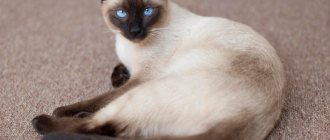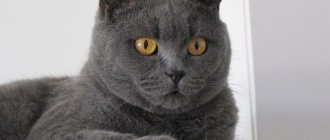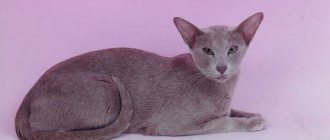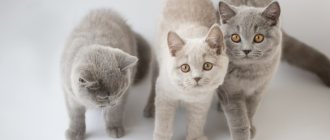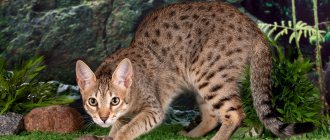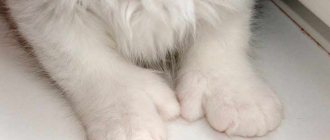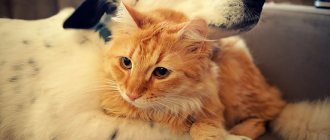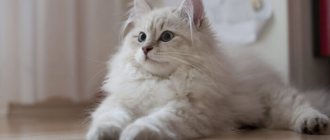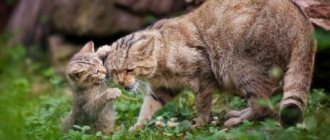People, no matter how much they strive for comfort and urbanization, always remember their roots: some are drawn to the village or forest, others grow exotic flowers at home, and still others even prefer unusual pets. Many animal lovers at home want to have a safe animal that is still similar to its wild counterparts. One of these is the domestic lynx - the dream of some cat fans. Zoologists and breeders have been working for decades to ensure that a smaller copy of a graceful forest animal and a merciless killer can live in a person’s home. Of course, it won’t be possible to keep a real lynx in an apartment, but it’s easy to pick up a cat that is very similar to it. Today we will talk about some representatives of domesticated cats that have a great resemblance to the spotted beauty of the taiga.
Domestic lynx and similar cats
Lynx at home
I would still like to say a few words about the possibility of keeping a real lynx in an apartment or house. In nature, these animals reach the size of large dogs, live in the remote taiga and are so careful that seeing them is a great success. These wild cats are capricious, have a tough character, and trying to tame an adult is extremely difficult; the maximum that can be achieved is that the animal will live in an enclosure and communicate with people through the bars.
The wild lynx is a serious and merciless animal
Professional trainers have successfully attempted to tame lynxes that came to them at a tiny age due to the death of their mother. Lynxes raised by humans or domestic animals (for example, a large breed dog) become quite accustomed to humans and their company, but their proximity to them cannot be considered completely safe. Lynxes have sharp claws and teeth; in addition, animals have the habit of attacking unexpectedly, from above, which can cause serious injury.
However, breeders working with zoos and forestries have worked to develop domesticated lynx. These are artificially bred cats obtained from mating the smallest wild lynxes and the largest domestic cats, which have similar features and coloring to lynxes. The domestic lynx is half the size of its wild relative and has a more predictable and docile character, but it cannot be said that this animal is suitable for any person. Zoologists are still working to improve the character of the breed.
Domestic lynx
The domestic lynx has retained all the external features of the wild lynx: flexibility, strong muscular build, characteristic spotted coat color, tufts on the ears. Domestic lynxes have beautiful almond-shaped eyes with a warm hazel color, a large, touching nose, and short hair with a dense undercoat. Wild relatives also passed on some of their willfulness to domestic lynxes - the pets turned out to be more similar in character to dogs, which imposes obligations on the owner to seriously raise the cat.
The domestic lynx is still an experimental breed. The Canadian lynx was chosen for its selection as the smallest representative of the genus. Feline breeders believe that this direction is very promising, since the first kittens have already been bred with an easygoing character and an appearance similar to a wild lynx.
Video - Five reasons not to get a lynx
Features of keeping as a pet
The Canadian lynx is an absolute predator; living in an apartment is strictly excluded. Some exotic lovers want to get a Canadian lynx as a pet. In this case, it is important to remember that such animals can only be in a private house with a large local area. In addition, it is preferable to organize an outdoor enclosure for the Canadian lynx, where it will feel especially comfortable in winter.
Caring for a lynx is not particularly difficult. It is important to provide the animal with living conditions that are as close as possible to their natural environment. It is recommended to feed the lynx raw rabbit meat, herbs, and fish. You should not give your animal fatty meats, such as pork.
In addition to organizing proper nutrition with an almost daily presence of rabbit or hare meat, small rodents and birds in the diet, it is necessary to give the animal the opportunity to express its hunting instinct - to hunt live game. It is necessary to regularly ensure that the lynx hunts a live hare; sometimes small rodents can be allowed in instead of a hare.
Hunting is a prerequisite for the normal life of a predator in captivity. If the Canadian lynx stops hunting altogether, this will lead to a weakening of its immunity, the animal will begin to waste away, which will negatively affect its overall health.
Caracal (lynx of the steppes): description
Another type of lynx that has been adapted for domestic keeping is the caracal. In fact, these are also wild cats that live in African territories, as well as in the reserves of the Caspian Sea. This species has become rare and even endangered due to active hunting of caracals, which in turn destroy domestic animals among the local population.
“Caracal” is a Turkish name, a translation of the word “karakalak”, translated as “black ears”. It is the darkened ears that are the main distinguishing feature of the animal. The caracal's ears are large, sharp and sensitive, with brush-like hairs remaining at the tips.
Caracals are born with black ears
These cats have short, thick fur that is sandy, red or copper in color. Almond-shaped charming eyes seem to be lined with black. The ears are set high on the graceful small head. An adult caracal can gain weight up to twenty-five kilograms, and reach half a meter at the withers. The body of the animal is elongated, cats “stretch” up to almost a meter, kitties are smaller. In general, the steppe lynx is unusually beautiful and eye-catching.
In recent years, the idea of domesticating caracals has become very popular, and more than a dozen nurseries around the world are breeding this breed for indoor use. Several generations of caracals have already grown up not just in captivity, but in close contact with people, and these animals become the gene pool for even more domesticated kittens.
Domestic caracal
However, keeping a steppe lynx, even if it is a domestic one, is not within the power of everyone - these are large animals, up to fifty centimeters at the withers, that need a lot of movement and free space. Domestic caracals are not kept in small apartments; a country house with its own territory, securely fenced, is more suitable for them. Some owners keep caracals in enclosures with free access to the street, but it is better when the cat constantly lives with people and is socialized.
It is worth considering that, like their wild counterparts, domestic caracals run very quickly, calmly take the height of any tree, swim excellently, and the length of their jump can reach four meters. When equipping the territory, you need to take into account these characteristics of the animal.
Like all cats, caracals are very playful.
The ability of caracals to be tamed is high, so they were quite easily able to move from the category of wild hunters to the category of pets. However, it will not be possible to bring a wild-born kitten into the house and raise it - the animal will retain all its instincts, including distrust of humans, excellent hunting skills, and will refuse affection and communication with household members.
Therefore, you can only take caracals from a nursery where the kittens were born and saw the light of day with people. Domesticated steppe lynxes are quite friendly, curious, and do not show aggression. But, people whose children are growing up should not have such a pet. In general, raising a small caracal is very similar to raising a puppy - the pet needs to be walked, taught commands, and conditioned to live in partnership and subordination with a person.
Like dogs, caracals are good at leash training.
Habits
The Canadian lynx leads a solitary lifestyle, rarely communicates with its fellows, does not stay in one place for long and constantly wanders within its own hunting grounds (occupying an area of 70 km 2 or more). Be sure to mark the territory: irrigate the soil with droplets of urine, leave scratches on rocks and trees.
It confidently moves through deep and loose snow cover, skillfully hides its tracks, swims well, and shows miracles of agility on the ground, in trees, and in cold water. It travels tens of kilometers in search of food. It waits out bad weather in the thick of the forest or in a suitable cave.
Unlike the common lynx, the North American species actively hunts not only under the cover of darkness, but also during the daytime. Looks out for the prey while sitting on a tree, or tracks it by scent and tracks. It sneaks up to prey and attacks sharply from an ambush, making several lightning-fast jumps of 2-3 meters each.
Caraquet - small caracal
Domesticated caracals, despite their enormous cost (can be compared to the price of a new foreign car), are popular among people. But not every person is ready to take a risk and test the strength of their nervous system, interior and wallet by getting such a large cat. Therefore, zoologists created an even more domestic type of steppe lynx - the caraquet.
In 2011, the first generation of these cats was born, and the ancestors of the breed were the steppe lynx, which breeders bred with three variations of domestic cats: Orientals, Abyssinians and Egyptian Mau. The hybrid turned out to be half the size of a caracal, has an easy-going disposition and poses less danger to humans. From caracals, caracats inherited a spectacular appearance: the same sandy shade of fur coat, black ears with tassels, grace and power. At the same time, the hybrid breed has high immunity, a lot of energy and a high level of activity.
Young caraquet
Breeders have done a lot of work on the psyche of Caraquets - these cats, like all domestic breeds, are friendly, affectionate and flexible. It is the combination of exotic appearance and wonderful character that determines the high price of kittens. The cost of an animal for castration or sterilization (that is, without the right to further breeding) is about a million Russian rubles.
There are four official caraquet nurseries in Russia, and their founders set as their goal the preservation of rare cat species, as well as the breeding of new hybrid breeds. The caracat is exactly the cat that completely reproduces the caracal, which is disappearing in nature, but at the same time the animal’s aggression has been “erased.” Let us note that caraquetas are tolerant even of small children, interact well with other cats and dogs, and are able to live in an apartment without going outside.
Charming big-nosed caraquet
Where can I buy
You can buy a Canadian lynx at a private or public zoo; it is almost impossible to find an animal from breeders. Nurseries for breeding Canadian lynx are practically not found, and they are located only in the regions of the animal’s immediate habitat. The cost of a lynx kitten starts from several thousand dollars.
Fans of such an exotic wild animal should understand that, having adopted a Canadian lynx, they must provide it with everything necessary for normal growth, development and health.
Pixie bob: mini lynx for the home
A wonderful domestic breed that is most similar to the lynx when it comes to tame and affectionate cats. This artificially bred breed is the fruit of the successful work of specialists from the USA. Pixie bob translates to “elf with a short tail.”
The first kittens were born in the 80s of the last century, from a domestic pet and a wild forest cat with a short tail. The breed's characteristics, such as a pear-shaped head, a spotted coat, and powerful “whiskers” like a real lynx, were fixed over several more generations, and the pixie-bob became incredibly popular.
The pixie bob also has tassels on his ears.
The standard breed characteristics of pixies are:
- The head is large, strong, the chin is wide and powerful.
- The ears are rounded, large, with tassels at the tips (there are individuals without them).
- “Heavy” wide eyes, pronounced brow arches, eyelids drooping, creating a stern look.
- Pixie-bob kittens have sky-blue eyes from birth; by six months the iris color changes to hazel, honey or green.
- The mirror of the large nose has a brown tint, the nose itself has a slight hump.
- The physique is powerful and heavy; the weight of an adult animal can reach ten kilograms.
- Wild ancestors “gave” the pixie-bob limbs of different lengths - the hind ones are higher than the front ones.
- The pixie still has a tail - it is desirable that it be five to seven centimeters in length and slightly “broken”.
- The pixie-bob has brown fur and characteristic spots; hairs are shorter on the body and longer on the belly.
Domestic cat with wild charm
Despite the fact that pixie bobs are strikingly similar to absolutely wild cats, they are very affectionate towards humans, have a balanced and even phlegmatic character, and are strongly attached to their family. It is the combination of appearance and docileness that makes the pixie a very common and popular breed abroad. In Russia, cat lovers are just getting acquainted with pixies.
Maine Coon: description
Maine Coons appeared in New York in the 60s of the 18th century. At that time the breed was little known, but at the turn of the 19th and 20th centuries it gained enormous popularity. At that time, Maine Coons were readily purchased by farmers, because the huge cats had serious hunting talents and could protect small pets.
Adult Maine Coon
Modern pets have retained the stamina and excellent health of their ancestors, but their character has changed over the years. From independent hunters, they turned into affectionate, loving and reverent pets. However, the behavior and psyche of Maine Coons is similar to that of a dog, which is why they are often called “cat-dogs.”
Maine Coon "wild" colors
Externally, Maine Coons still resemble wild cats - large sizes, tufts on the ears, and a variety of native colors. An adult cat is characterized by a heavy, massive jaw, large, attentive eyes, and powerful paws that cover half of a human palm. A person who wants to have a mini-copy of a wild cat in their home should take a closer look at striped, spotted or marbled Maine Coons. However, if there are colors that practically copy lynx spots.
Maine Coons are record holders
Norwegian Forest Cat: Description
The Norwegian Forest Cat is a giant with a gentle character. This breed is similar to Maine Coons due to their lush coat, impressive size and variety of colors, but the roots of these breeds are different. We can say that the first representatives of this breed appeared by chance, as a result of the mating of a domestic “spring” cat with a wild cat from the Norwegian forest. When the cat gave birth, people assessed, first of all, the hunting abilities of the grown kittens.
So they began to work on the breed purposefully. The result was large animals with a restrained, calm character, independent, but attached to home and people. These cats have a very strong psyche, adapt perfectly to any situation, and therefore are even able to travel with their owner.
Norwegian forest cat
The breed is characterized by thick wool with a dense undercoat, which protects the animal from any weather. A person looking at a Norwegian cat gets the impression of power and wild, primitive strength hidden under the gentle and gentle appearance. Indeed, modern “Norwegians” have retained all the qualities of hunters, and, if necessary, are able to defend themselves even from a large dog.
Bobtail from the USA: characteristics
This is a fairly old and well-known breed of cat, which was bred in America in the 50s. American bobtails resemble wild lynxes with a short tail, squat body structure, spots on the coat and a heavy, sullen look. These are quite large cats, capable of reaching a weight of eight to nine kilograms.
American Bobtail cat
The description of the breed includes the following characteristic features:
- Wedge-shaped, large rounded head.
- Medium-sized triangular ears topped with tassels.
- Big, open eyes.
- Athletic but stocky build.
- Wide nose.
- Flexible but short tail ranging from two to seven centimeters long.
- Elastic luxurious coat with dense undercoat.
American bobtails can have different shades of coat: black, cream, red, blue. But the most prized wild colors are “marble” and “tabby”, characterized by spots or dark patterns throughout the cat’s coat.
Marbled Bobtail
The character of the American Bobtail allows him to be a true favorite of the whole family: these cats are gentle, moderately active, obedient and loving. In addition, the breed has no health problems and is a long-living breed: up to fifteen years.
Summarizing
Table. Comparison of cat breeds similar to lynxes
| Dimensions, weight | Cost of a kitten | Character | |
| Caracal | Weight up to 25 kilograms, at the withers up to half a meter. | From 600 thousand rubles to 1.5 million | Can be aggressive |
| Caraquet | Weight up to 15 kilograms, at the withers up to 40 centimeters. | From 500 thousand to 1.2 million rubles | An experimental breed in which breeders are trying to get rid of aggression |
| Maine Coon | Weight up to 15 kilograms, at the withers up to 35 centimeters. | 30-70 thousand rubles | Affectionate but capricious |
| Bobtail USA | Weight up to 9 kilograms, at the withers up to 30 centimeters. | 25-50 thousand rubles | Gentle, obedient |
| Norwegian forest | Weight up to 10 kilograms, at the withers up to 30 centimeters. | 25-50 thousand rubles | Independent, friendly |
| Pixie bob | Weight up to 8-9 kilograms, at the withers up to 25 centimeters. | 50-100 thousand rubles | Phlegmatic, calm, flexible |
A person who likes the appearance of a wild lynx may well have a miniature pet. There are several breeds of cats that are more or less similar to lynxes. Therefore, choose a pet that will please the eye, but not burden your wallet and everyday life.
How does a lynx reproduce?
Pets of different sexes reach sexual maturity at different times. Female - 1-1.9 years, male - from 1.5 to 2.9 years. The mating period for the common lynx is from January to March, for the red and Canadian lynx - from February to June. The mating of the female and male is accompanied by a loud cry. Fights often occur between males. A pair of lynxes, having given preference to each other, gently rub their foreheads.
The gestation period lasts from 63 to 74 days. Small lynx cubs are born, as a rule, in late spring or early summer.
A lynx's refuge is a den under the roots of an upturned tree, a low hollow, a cave, rock crevices, a hole or a windfall. In any of these places, the female prepares the nest, lining the bottom with animal hair. In one litter there are from 1 to 6 babies, but mostly 2 little lynxes are born.
Newborn lynxes weigh 245-300 grams. Animals are born helpless: blind and deaf. Eyes open on the 12th day. A month later, the female begins to feed the cubs solid food.
